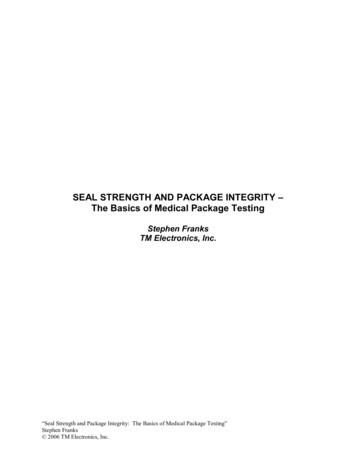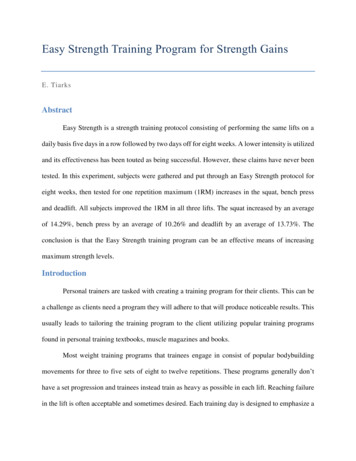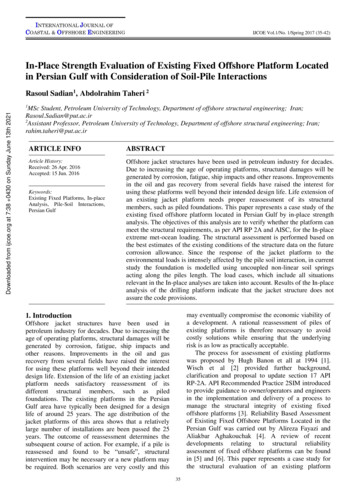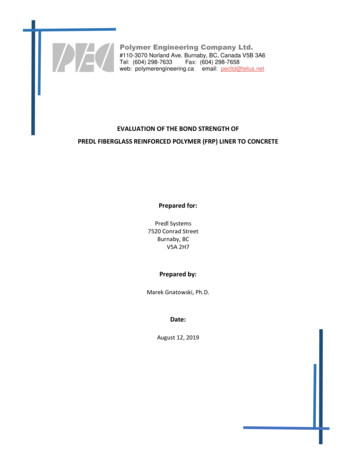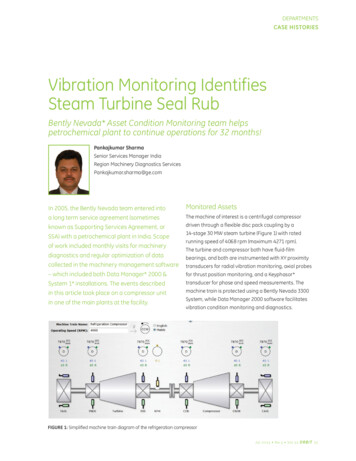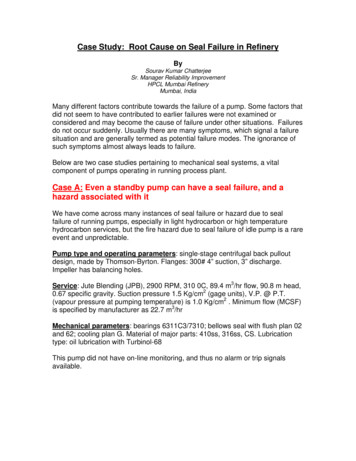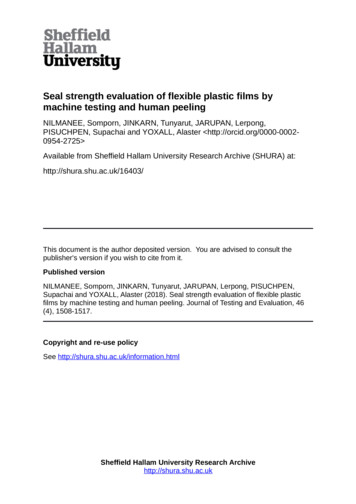
Transcription
Seal strength evaluation of flexible plastic films bymachine testing and human peelingNILMANEE, Somporn, JINKARN, Tunyarut, JARUPAN, Lerpong,PISUCHPEN, Supachai and YOXALL, Alaster http://orcid.org/0000-00020954-2725 Available from Sheffield Hallam University Research Archive (SHURA) at:http://shura.shu.ac.uk/16403/This document is the author deposited version. You are advised to consult thepublisher's version if you wish to cite from it.Published versionNILMANEE, Somporn, JINKARN, Tunyarut, JARUPAN, Lerpong, PISUCHPEN,Supachai and YOXALL, Alaster (2018). Seal strength evaluation of flexible plasticfilms by machine testing and human peeling. Journal of Testing and Evaluation, 46(4), 1508-1517.Copyright and re-use policySee http://shura.shu.ac.uk/information.htmlSheffield Hallam University Research Archivehttp://shura.shu.ac.uk
This is a preprint of an article accepted for publication in Journal of Testing and Evaluation, Copyright@ 2017, ASTM International, West Conshohocken, PA, DOI: to followFull publication information including DOI can be found on the SHURA record for the publication,once publication information is available: http://www.shura.shu.ac.uk/16403/Page 1 of 15
Seal Strength Evaluation of Flexible Plastic Films by MachineTesting and Human PeelingSomporn Nilmanee1, Tunyarut Jinkarn1*, Lerpong Jarupan1, Supachai Pisuchpen2,and Alaster Yoxall3ABSTRACT: The seal strength of flexible packaging indicates both functional performance andthe ease of opening. This research aims to compare the seal peeling mechanisms evaluated byhuman participants and standard machine tests. The tests were conducted on flexible films usedfor typical packaging applications, LDPE, LLDPE and Nylon/LLDPE. Human peeling wassimulated through the use of novel force measurement equipment. The results showed that themaximum machine peel force set by standard test methods was generally lower than the humanpeel force for most sealing temperatures. In all film types no significant difference was shownbetween genders although for people over 65 years peel force was generally lower than for theyounger cohort. The results also indicated that peeling speed of human participants was normallyhigher than the peeling speed set according to the machine test standard.KEYWORDS: seal strength, packaging, human peeling, ease of opening, flexible plasticIntroductionManufacturers usually measure and control the seal strength of bags or pouches made fromflexible packaging materials by testing peel force. Further, manufacturers usually measure sealintegrity to ensure a hermetic seal and product quality control. In general the seal strength of aheat sealed flexible pouch may vary, and can depend on the types of materials used for thesealing layer, the seal temperature, dwell time and pressure of the sealing jaw [1-2]. Since sealstrength is one of the most important quality characteristics for evaluating packagingperformance, researchers have attempted to analyze the seal strength of flexible packaging byvarying packaging materials or sealing parameters by using standard testing procedures [3-10].Other than the force measurement through the use of testing procedures, some studies havedeveloped measuring techniques for the human peeling force of flexible packaging and films.Canty et al. [11] measured finger friction between pack and finger by an observational analysison 60 users and the result indicated that the issues surrounding accessibility of this pack formatwere related to dexterity not strength. Liebmann et al. [12] also demonstrated the assessment ofthe human force necessary to open peelable packaging whilst Mark et al. [13] investigated the1Department of Packaging and Materials Technology, Faculty of Agro-Industry, Kasetsart University, 50 NgamWong Wan Rd, Lat Yao Chatuchak Bangkok 10900 Bangkok, TH 10900 (Note: Go to www.ku.ac.th for details, email:fagitvp@ku.ac.th)2Department of Material Product Technology, Prince of Songkla University, Songkhla, 90110, Thailand; PSU (Note:Go to www.psu.ac.th for details, email: supachai.p@psu.ac.th)3Art and Design Research Centre, Sheffield Hallam University, Sheffield, Howard street, S1, 1WB, UK; SHU (Note:Go to www.shu.ac.uk for details, email: a.yoxall@shu.ac.uk)* Corresponding Author, Email fagitvp@ku.ac.thPage 2 of 15
forces people could apply to aluminum or plastic tear tabs of different lengths. According to thisstudy, participants were able to apply most force to the longest aluminum tab, using the key grip.There has also been significant interest in the openability of packaging in other formats,including blister packages, bottles, trays and glass jars. These studies have used speciallydesigned force measurement devices for evaluating the opening forces or optical cameratechniques to measure grip motions. Rowson et al. [14] undertook one of the earliest studies onmedical blister packaging using motion-capture, grip and dexterity analysis. The resultsidentified the four common types of grips used, and that participants generally had a preferredgrip style. Moreover, the study also confirmed that dexterity decreases with age. De la Fuente, C.J. [15] undertook a study on the peeling angle of a semi-rigid tray with peelable lid. This studyalso covered the relationship between tab size and grip choice. The results showed that the meanpeel angle fell within the theoretical optimal peel angle range for the tray (α 45 15 ). Thestudy also showed that the grip preferences for the peeling also depended on the tab size. Workby Carus et al. [16] studied the initial testing of a novel multi-axial force and torque transducerfor tamper-evident bottle closures. The results showed that the elderly and the young groupsexhibited significantly different torque and force profiles when attempting to open the bottles.Similar work was also conducted by researchers focusing on the opening force measurement andopening postures of bottles and jars [17-26].This interest in understanding the issues aroundopenability has led to the development of European and international guidelines on themeasurement of packaging seal forces and user test panel methods. The European technicalspecification DD CEN/TS 15945 [26] launched in 2011 sets out a framework for ease of openingevaluation for packaging and has more recently been superseded by ISO17480. The technicalspecification describes a user panel test for the qualitative evaluation of a packagingperformance. The specification also describes a series of possible mechanical tests that can beused to evaluate ease of opening for a pack.Many standards exist for the testing and evaluation of packaging materials and packs suchas the measurement for heat sealed soft and semi-rigid packages based on JIS Z-0238 [2],mechanical seal strength testing for round cups and bowl containers with flexible peelable lidsbased on ASTM F2824 [15] and standard test for seal strength of flexible barrier materials fromASTM F88 [27]. In addition, the standard DIN 55529 also provides criteria for determining sealstrength of flexible packaging materials. Besides measuring of the seal strength, the peeldelamination between flexible material layers can also be done via ASTM D1876, Standard TestMethod for Peel Resistance of Adhesives (T-Peel Test) [28]. However, according to theestablished international standards, peeling setup for measuring the seal strength and measuringthe peel delamination are different.Although there are standard evaluation procedures and a significant number of studiesrelating to seal peel forces using recognized testing machines and procedures, the level of howwell these testing procedures can accurately access the forces and speeds of peeling a sealedflexible film by humans has not yet been identified. Hence a study was proposed to measure thepeel forces of a common sealed flexible packaging material using testing procedures through astandard testing machine and then to compare those peel forces to a set of measured forcesderived from human testing. Elongation at break and peel speed were also compared andanalyzed as part of this study along with the effects of age and gender of participants.Page 3 of 15
Materials and MethodsSample preparationThe flexible commercial films selected for testing included a low-density polyethylene (LDPE70 µm), linear- low-density polyethylene (LLDPE 70 µm) as well as Nylon15/LLDPE45 µm.LDPE and LLDPE were selected since they are primarily used as a sealing layer for mostflexible films due to their low heat sealing temperature. The heat sealing machine used in thestudy was the MTMS from Japan (Fig. 1(a)). All films were preliminary tested to understand therelationship between seal strength vs temperature profile. After this preliminary analysis, thetemperature of the MTMS sealing bars were set at 112, 114, and 116 ºC for LDPE and LLDPEand the bar temperatures for Nylon/LLDPE were set at 109, 111, 113 ºC. Seal pressure was keptconstant at approximately 0.3 MPa and dwell time was controlled at one second throughout allsealed samples. The objective of these differing seal condition settings was to produce thevarying seal strength for the subsequent seal strength tests.FIG. 1―Heat seal equipment and tensile testing: heat sealing machine MTMS device, controlunit (a) manual heating press (b) cooling press (c) and sample griping on universal testingmachines (d).Page 4 of 15
Seal strength measurementFollowing the sealing process, all samples were kept for 48 hours at room temperature tocondition the seals to achieve maximum seal strength. The sealed film samples weresubsequently cut into strips of 15 mm width and 100 mm length as per ASTM F88 (2012) shownin Fig. 2. During the heat sealing process, Teflon sheets of 0.1 mm thickness were placedbetween the film and the heating jaw to prevent sticking (Fig. 1(b)). The sealed films werecooled in ambient conditions by the use of a cooling press as shown in Fig. 1(c). The sealstrength and elongation at break of the commercial films were measured using a UniversalTesting Machine (5900 series, Instron Ltd., Bucks, UK). Each leg of the sealed specimen wasgripped in the opposite direction (180 degree) by the fixed and moving jaws of the force testingmachine so the seal was equidistant between the two grips, and aligned laterally so the seal isperpendicular to the direction of movement of the grips. The loading speed of the test was set at10 inches/min (254 mm/ min) under a loading cell of 5KN. After the test, maximum forcerequired to tear apart the seal was recorded. The distance of an initial grip of the sample at themachine was 50 mm for all tests (Fig. 1(d)).Human force measurementFor the human force measurement test, age, gender, weight (kg), height (cm) and size of palm(width and length) of participants were recorded along with the peak force and the average peelspeed. This test used a digital force gauge (Desik, DS-500, Germany) to measure the peak forceof each participant, whilst a high speed camera (Model: Photron, SA3, USA) and PhotronFASTCAM Viewer software with the frame rate as 1000 fps, resolution at 1024 x 1024 wereused to analyze the peel elongation. Each participant was asked to pull a sealed sampleperpendicular to the seal area by fixing the end of each sample with the force gauge and holdingthis in one hand whilst pulling the other end with the other hand (Fig. 3(a)). The peel angle wascontrolled while testing at 180 degree. The seal peel with the digital force gauge was conductedon the table top to force the participant to peel toward the opposite side at keeping the peel level.Force of pulling the seal was undertaken for both hands of participants. Elongation of the filmswas measured by placing a ruler along with the pulling distance (Fig. 3(b)). Video analysis of thepeeling from the high speed camera recorded a total time required to complete the seal and filmelongation starting from an initial grip until the end of pulling was also recorded in order tocalculate the peel speed of the test. The statistical analysis of the mean values between humanand machine testing was conducted through analysis of variance (ANOVA) using SPSS version17 and the post hoc tests were conducted through Duncan's multiple-range test. Testingprocedure conducted with human was approved though the internal review board committee(Sheffield Hallam University Research Ethics committee) and before conducting anyexperiment, testing procedures were explained to all participants and consent gained.Page 5 of 15
FIG. 2―Sample sizeFIG. 3―Setup of human force measurement: force measurement equipment and setup (a) andfilm elongation evaluation (b).Experimental ResultsParticipants of the testA total of 24 participants were recruited from the Sheffield area of the UK with the descriptionof the participants shown in Table 1. Participants were classified into four age groups. During theexperiment, the test was conducted with one participant from each age group at a time.Differences of maximum peeling forces and peeling speeds were compared between each set ofparticipant in each age group. A minimum of 5 set of participants were used for the test since thePage 6 of 15
differences of physical performance such as weight, height and average hand dimension as wellas peeling forces and peeling speeds among each participant in each age group cohort were notsignificantly different.TABLE 1―Participants for the test.Age (year)Male% (n)Female% (n)Total %(n)Averageweight(kg)Averageheight(cm)Average palm dimensionlength x width (cm)18-3031-5051-6566- 29(7)25(6)21(5)25(6)100(24)71.5( 8.88)83.8( 15.87)96.2( 13.54)68.6( 14.62)80.0 ( 10.94)172.2( 9.98)173.0( 5.97)164.5( 9.45)164.0( 4.86)168.4( 4.19)17.6( 1.43) x 8.4( 0.90)18.1( 0.20) x 8.1( 0.37)17.9( 1.21) x 7.9( 0.68)17.4( 0.49) x 7.9( 0.49)17.7( 0.27) x 8.1( 0.20)Total/AverageComparison of human and machine peel forces and elongation at breakPeel forces of p
ASTM F88 [27]. In addition, the standard DIN 55529 also provides criteria for determining seal strength of flexible packaging materials. Besides measuring of the seal strength, the peel delamination between flexible material layers can also be done via ASTM D1876, Standard Test Method for Peel Resistance of Adhesives (T-Peel Test) [28]. However, according to the established international .
